Spain has been a feared football nation since winning the EURO 2008, 2012, and FIFA World Cup 2010. From time to time, they have a good number of players emerging from academies across the country and this year’s Spain U21 is also the same. Since Luis de la Fuente has moved to the first team to replace Luis Enrique, Santi Denia became the new coach of U21 just six months before the tournament.
Despite working for several national youth teams since 2010, this was the first time Denia took charge of the U21s — and he only had two games in March to get familiar with his players. In this tactical analysis, we are going to introduce the Spain squad and Denia’s tactics with the team.
Predicted starting XI
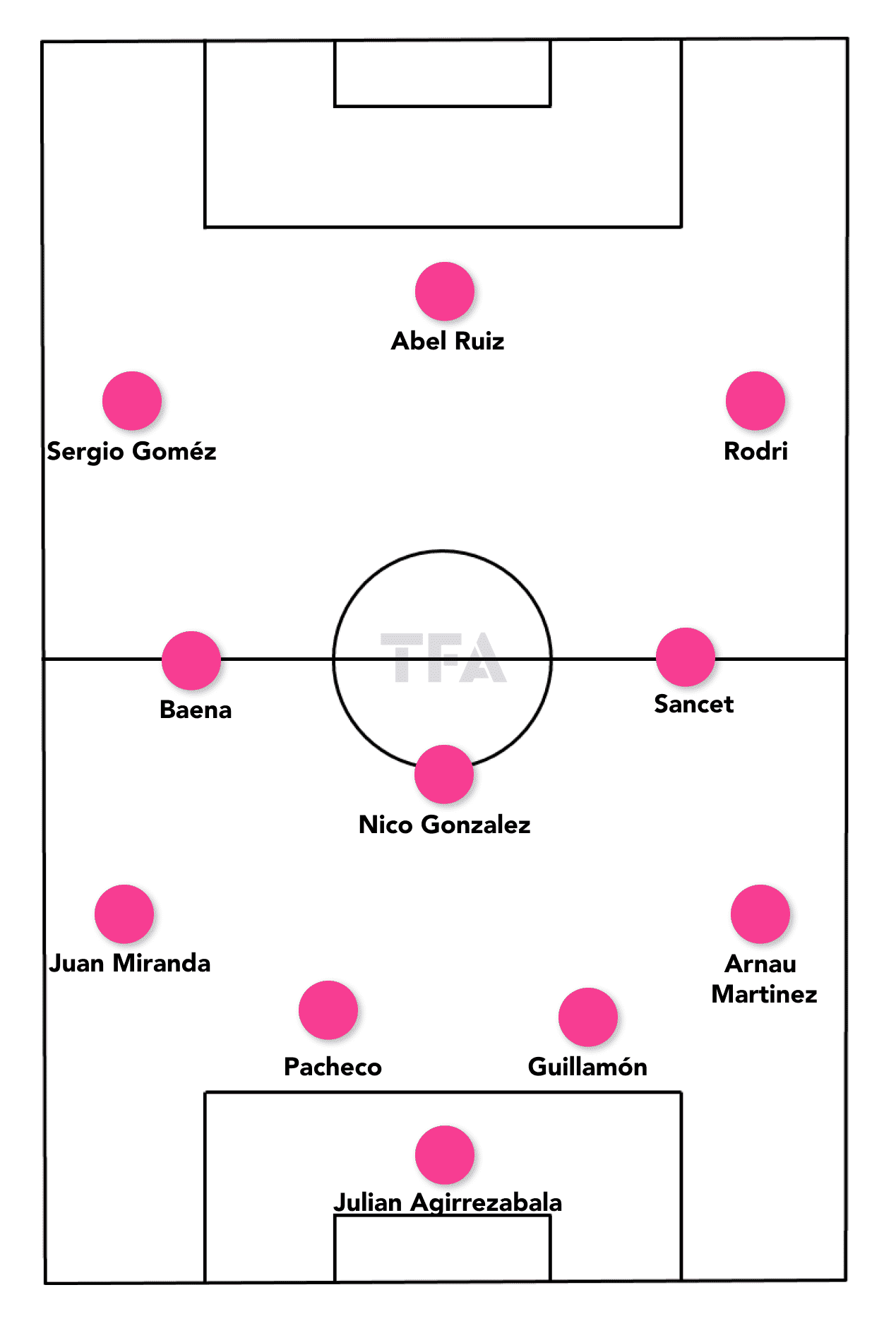
A very typical Spain national team usually lines up in a 4-1-2-3 formation. Although there is a proposed lineup in the above image, we felt that Denia could still make adjustments in several positions based on the condition of the players and the quality of the opponents. Some players such as Abel Ruiz, Rodri Sánchez, Jon Pacheco, Álex Baena, and Oihan Sancet are quite likely to be regular starters in this tournament. They are the backbone of the team with also many professional appearances in top leagues.
However, there are positions in which Denia might consider different options. For example, if Rodri started on one flank, then who could play as the winger on the other flank? If he opted for more control, Manchester City player Sergio Gómez could start as he thrives at connecting with teammates and passing the ball. But when the team needs to attack with more individual quality and directly attack the opponent, Rodrigo Riquelme could be the perfect candidate.
The same goes for Nico Gonzaléz and Antonio Blanco — both have their respective pros and cons and the most in-shape player should start.
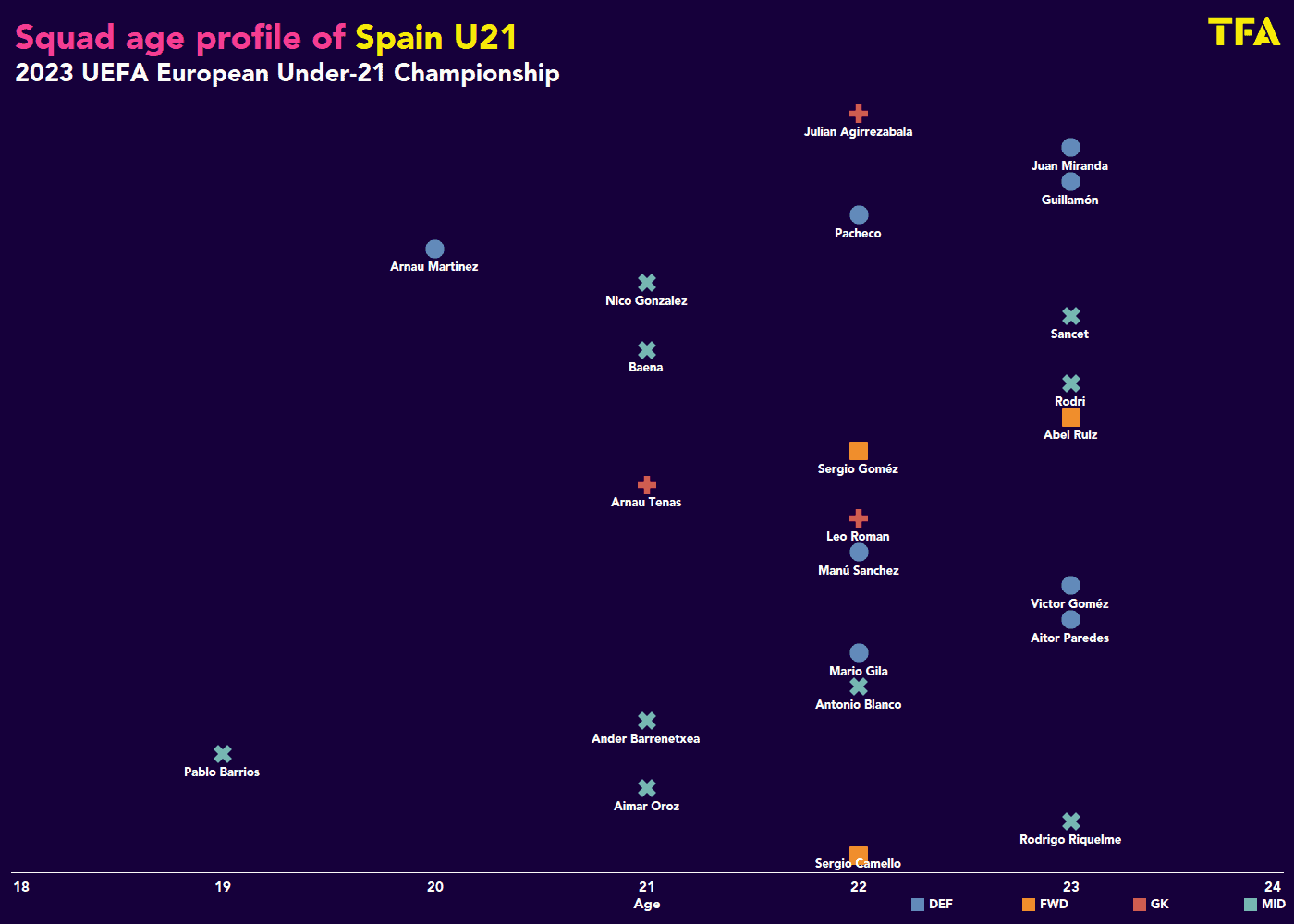
The squad age profile above suggests Spain have a lot of players at 23, such as Sancet, Rodri, and Ruiz who are likely to start, this will be an advantage to the team as they’ll offer more experience from the highest level of football. In fact, their only player below 20 in our graph is Pablo Barrios.
Attacking phase
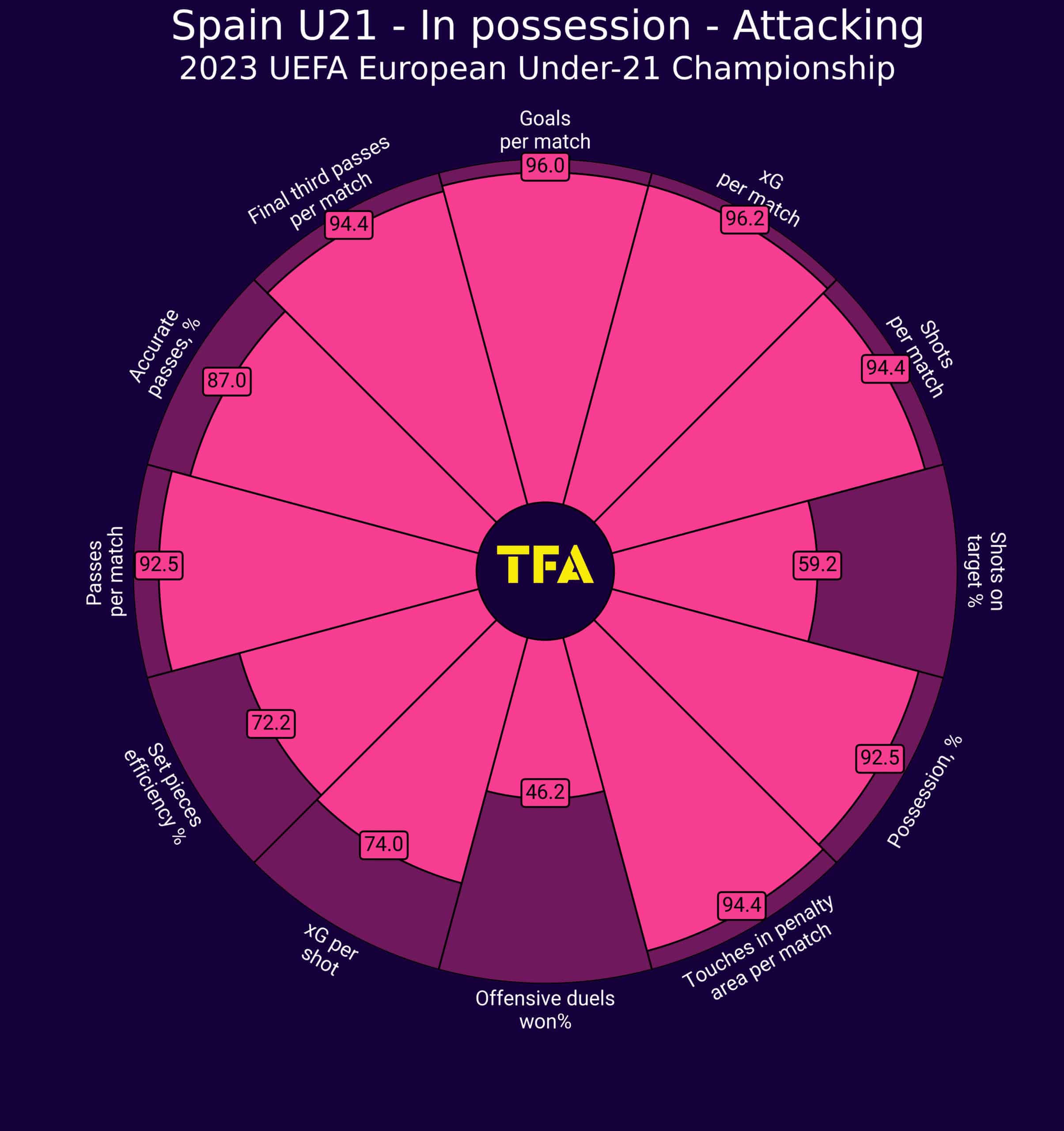
We can already develop a good idea of the playing style of Spain U21 with this chart. Clearly, they try to play on the front foot with good ways to enter the last third, as their percentile ranked 94.4 at final third passes per match. All the metrics above suggest they attacked a lot, dominating possession at 92.5 percentile rank, while having a 94.4 percentile rank at touches in penalty area per match. With 96.2 percentile xG per match, they’ve certainly shown their capability to create a lot of chances, while shots per match percentile at 94.4 and goals per match percentile at 96 also suggest we should expect Spain to offer a lot going forward in the tournament.
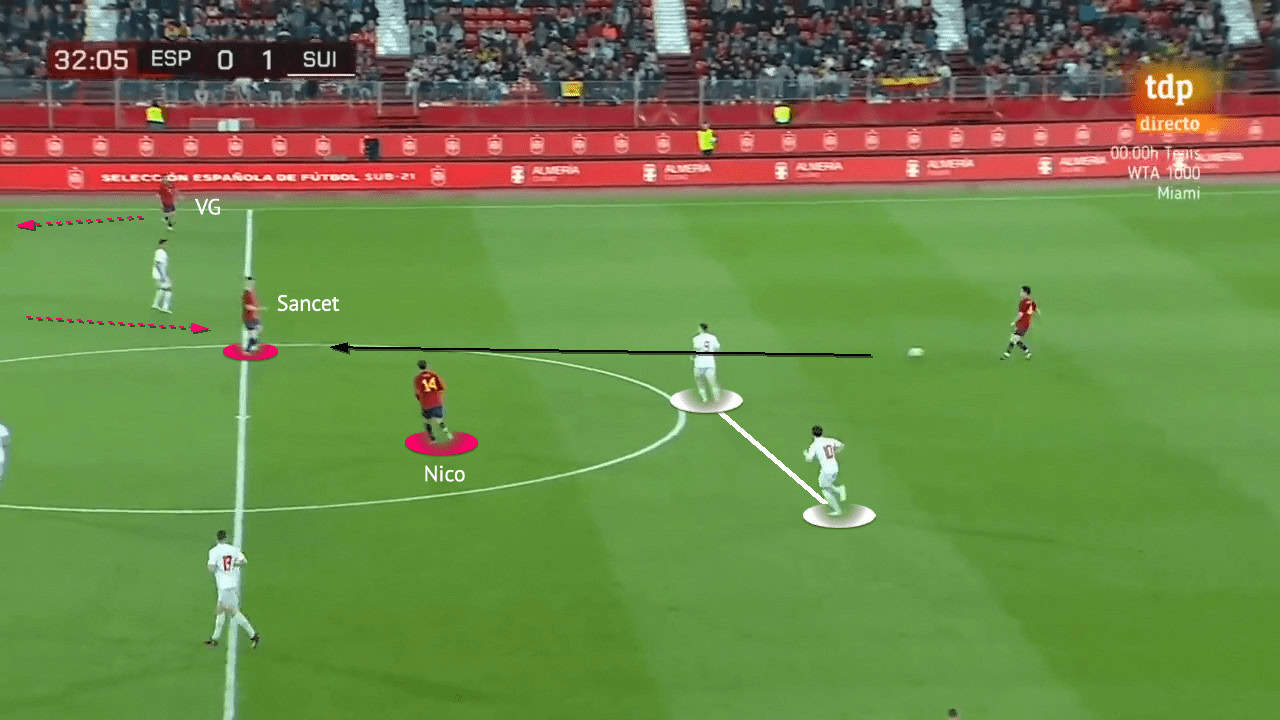
Something that won’t come as a massive surprise is that Spain like to keep the ball on the ground, with passes and combinations. In the build-up, their holding midfielder — Gonzaléz or Blanco should be able to dictate the space in the centre. However, the opponent also tend to mark this position so they might not always be free to receive. That’s why Spain also need an 8 to drop deeper to help. Sancet carries this role in the match with Switzerland while Baena played deeper in the game versus France.
As shown in the above image, Spain were quite efficient at playing out from the back when Sancet dropped and stayed next to Gonzaléz, because it allowed quick combination or third-man plays. While the full-back could be tasked with playing wider and going high in the attack. The central defenders of Spain also have different skill sets. Hugo Guillamón is a good passer who can break lines vertically with disguises. Meanwhile, Pacheco is also comfortable on the ball, but he has a stronger desire to drive forward and play long-range balls.
But Spain also had to pay more attention to getting the right rhythm when they have the ball. Because in the last two friendlies, sometimes they moved the ball too fast or were reluctant to use the goalkeeper as a transit point. They also had a tendency of moving the holding midfielder away from the centre; the consequence of that tactical move was losing coherence to offer options for the ball holder and connection in the centre. So, there are quite a lot of things to develop as a team when they go to the tournament.
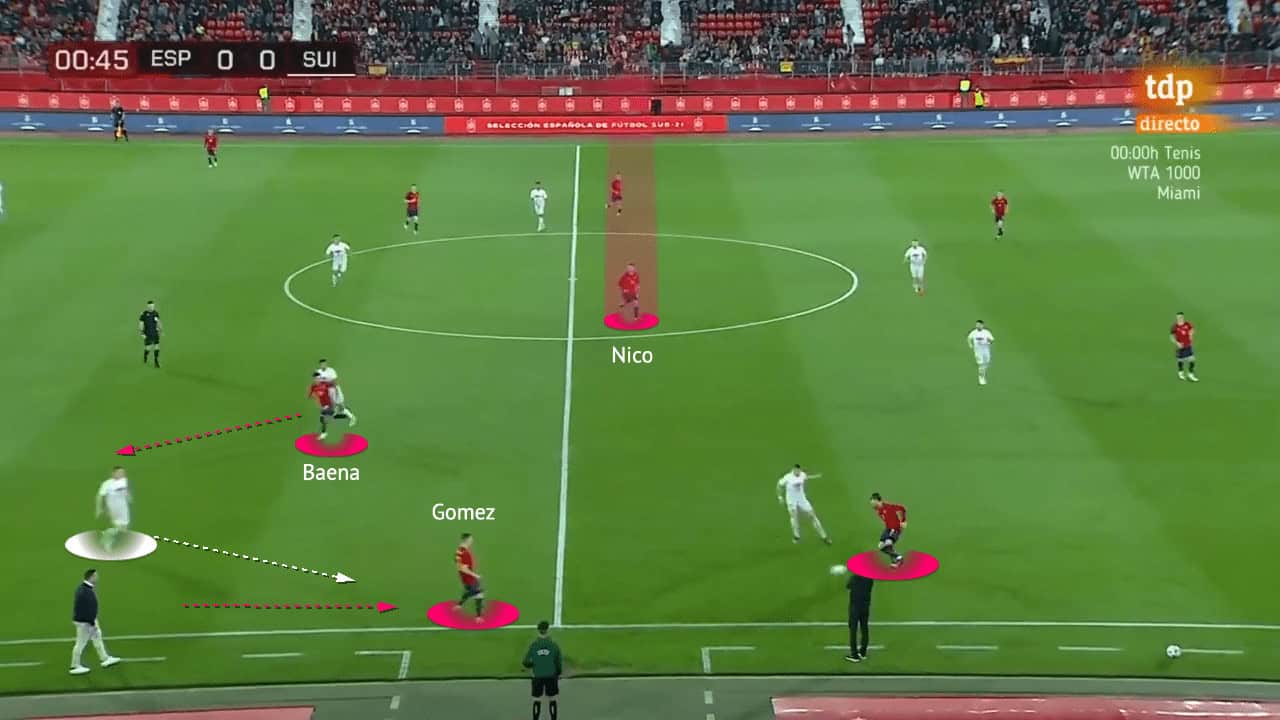
If Spain are playing in the centre, they want the receiver to turn between the lines so they could face the defenders and look for the final pass. But Baena has been caught lacking the ability to sense the moment to turn at times when his body angle did not cooperate. While Ruiz could drop and help the attack, he tended to play to the side he face instead of turning in tight margins.
But Spain could also attack via both sides with rotations. The above image shows an example of left-side movements — as Sergio Gómez dropped to attract the right-back to press, then Baena made a forward run into that space, bringing his marker away from the centre. When the space in the centre is presented, Juan Miranda enjoyed the opportunity to play a one-two and make an underlapping run in order to carry the ball forward. Meanwhile, look at Gonzaléz’s position, he was more dictating the centre, and if the attack could go forward, Spain would not need him to function the attack from side to side.
On the right side, Rodri is important to the team. The talented Real Betis winger is given the freedom to roam infield and receive the ball at feet. He could combine with teammates at close distance but he could also take on the opponent if the situation required.
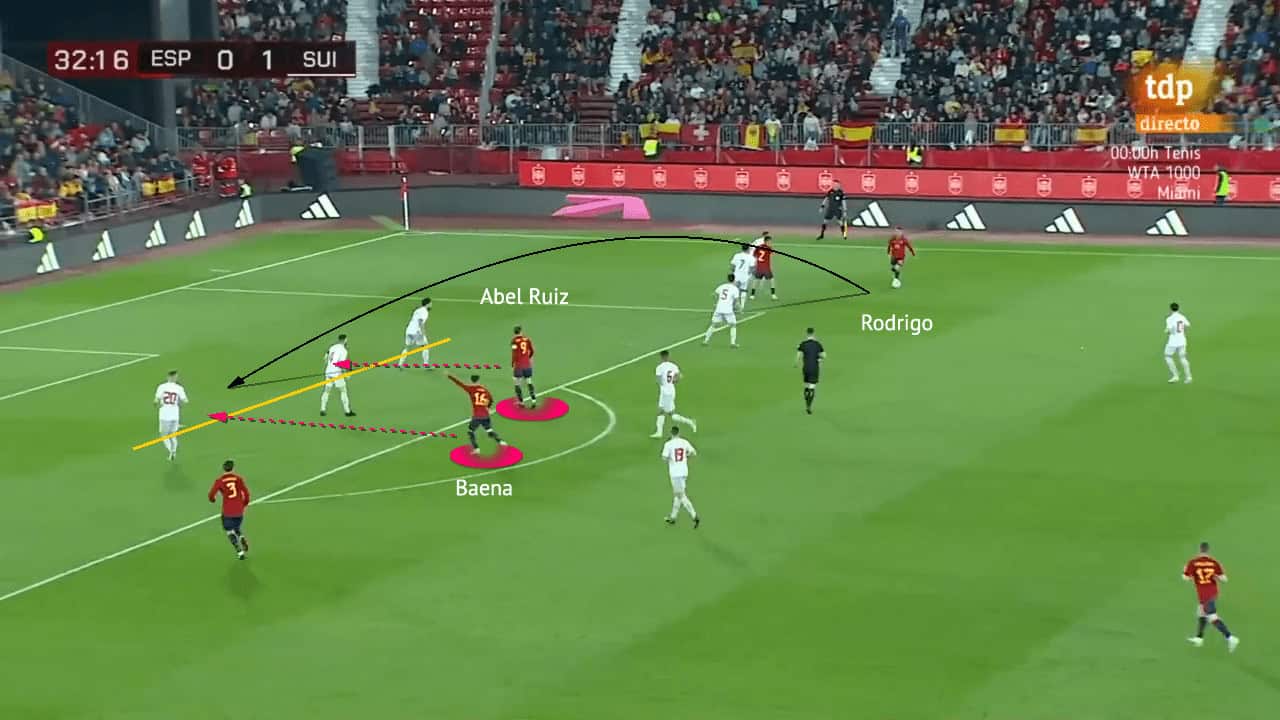
In the finishing actions, Ruiz, of course, would be the main man to connect but the Braga striker was not a fixed point in the box. As we explained a little bit in the above analysis, Ruiz also had a tendency to drift towards the sides or to stay close to the ball instead of distancing himself from it. But the consequence of this behavioural pattern was he might not always be in the box, so Spain needed other players to help when they arrived in the opposition third.
Usually, it would be Baena joining Ruiz in the penalty box so the two can make various movements to cause problems for the defence. For example, Ruiz could dislocate or imbalance the defence with his position to attract, then open spaces around the second post for Baena to arrive from deep. Furthermore, Miranda also showed his offensive desire by going high and even into the box very often as a left-back, so Spain had enough numbers to attack the cross.
Defensive phase
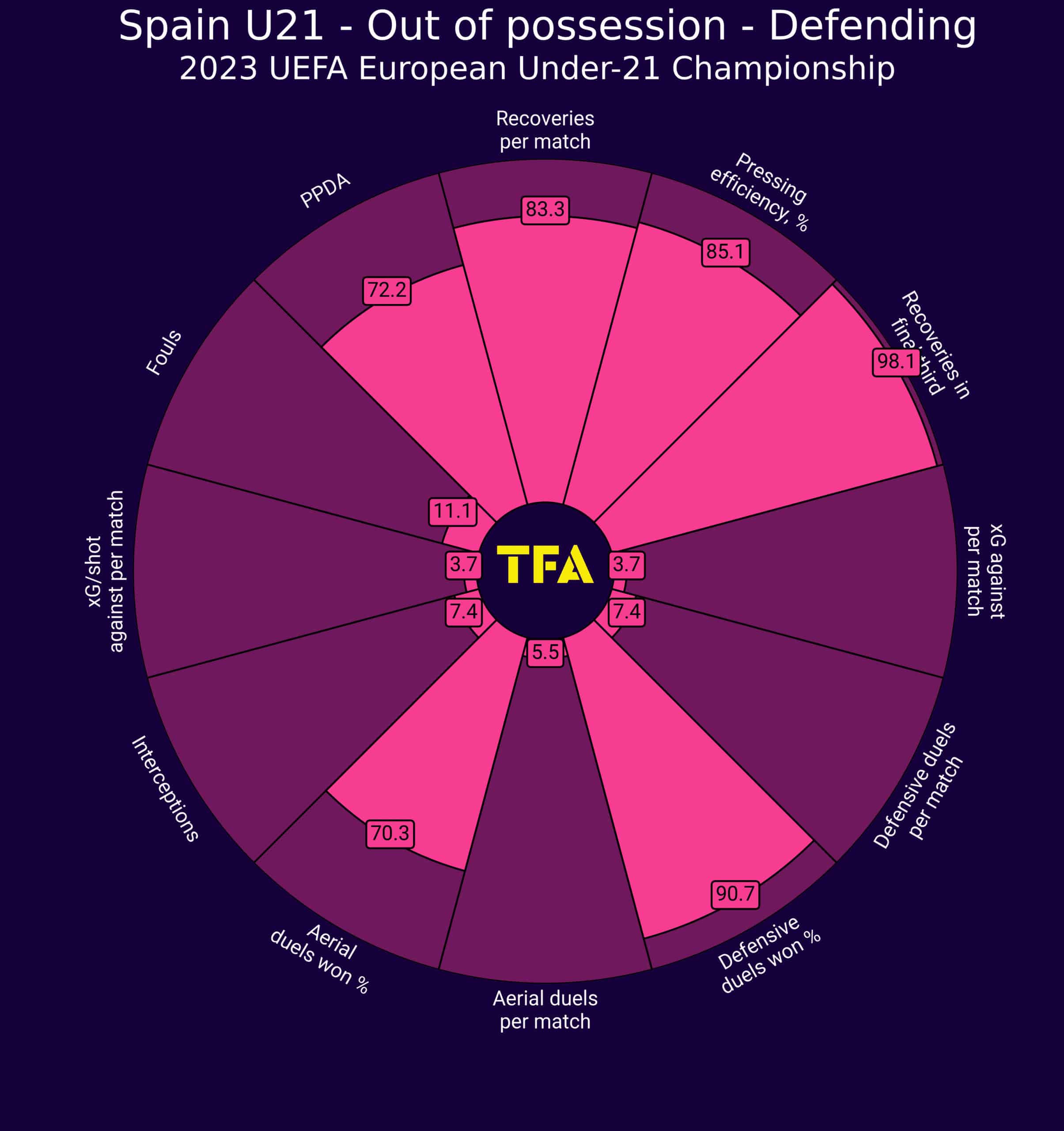
Spain like to press when they are without the ball, with promising numbers in several aspects of the game. But they are not a very physical side, so they try to reduce the battles in the air as their aerial duels per match percentile was at 5.5, although the aerial duels won % percentile at 70.3 was high. They were also quite effective at stopping the opponent’s ball progression, as the defensive duels won % percentile at 90.7 was above average. In general, Spain had a good ability to win the ball back in both high areas and around their third, as their recoveries in the final third was impressive at 98.1, and recoveries per match percentile were also at a high ranking at 83.3. When it comes to preventing the opponent to generate goalscoring chances, Spain also had a good percentile ranking at 3.7 xG against per match.
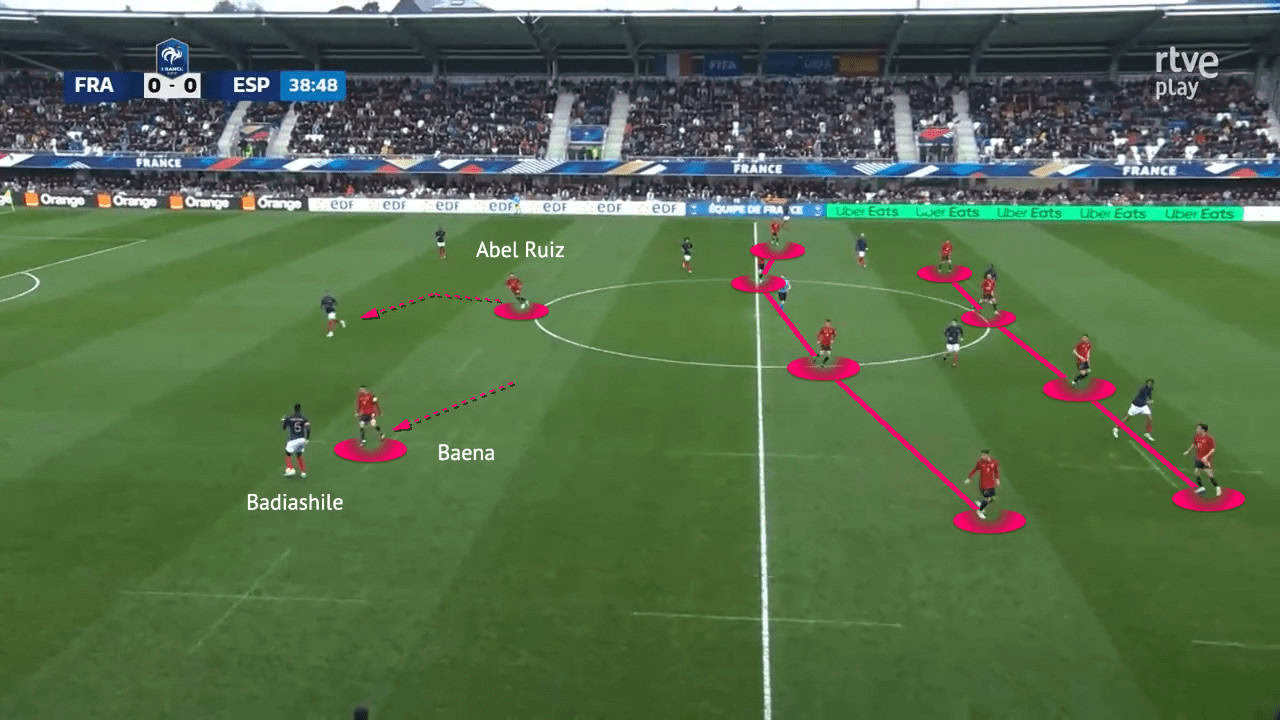
Here, we included some examples from Spain’s game to illustrate how they set up defensively. Pressing high is not necessary, as Denia wants his side to control the spacing more instead of only putting pressure on the opponent. So, Spain was always trying to manage the spacing before going to press the opponent. To allow the team to be more organized in the pressing game, the first line tried to defend directionally rather than always running straight to the opponent.
In terms of shape, Baena often joined Ruiz in the first line as a 4-4-2 formation, but it was more a consequence of how they tried to structure the press — not the end goal itself. On some occasions, they could still be defending in a 4-1-2-3 with more midfield coverage in the centre. But one thing we didn’t really see so far was the winger leading the press. Contrary to jumping, Rodri and Sergio Gómez/Riquelme tended to hold a deeper position to contain initially.
Hence, Spain did not always engage the central defender. France and Chelsea centre-back Benoît Badiashile had good room to play with the ball in this friendly game. Although the above scene shows Baena has jumped, and Badiashile tried to go centrally and find his partner but Ruiz was already there to angle his run to push the opponent to one side. The angle of Ruiz’s press would close the receiver’s angle to the other side, so the rest of the Spanish defenders could shift across to the expected half of the ball to net it.
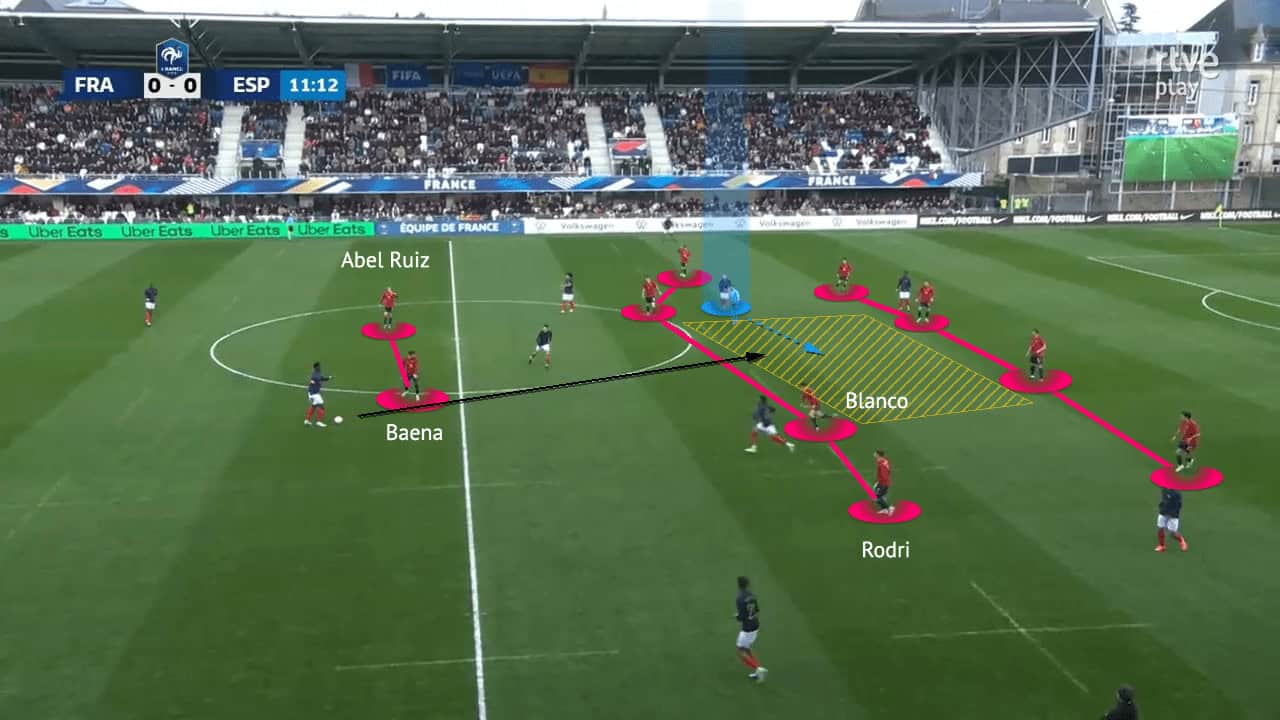
However, failure to apply pressure on central defenders would also be a problem for Spain if the opponent has players with good technical ability — Badiashile of France would be an example of such a player. When Baena stepped high but was unable to manage the angle in the press, Spain only had two midfielders remaining in the 4-4-2, exposing central spaces because the holding midfielder became parallel to his partner, instead of being in a position to cover.
As shown in the above image, it was so easy for Badiashile to break lines and Spain were not too effective at closing the space highlighted in yellow. Despite Blanco having decent defensive awareness, tactically and structurally this would be a weakness of the team that may require attention.
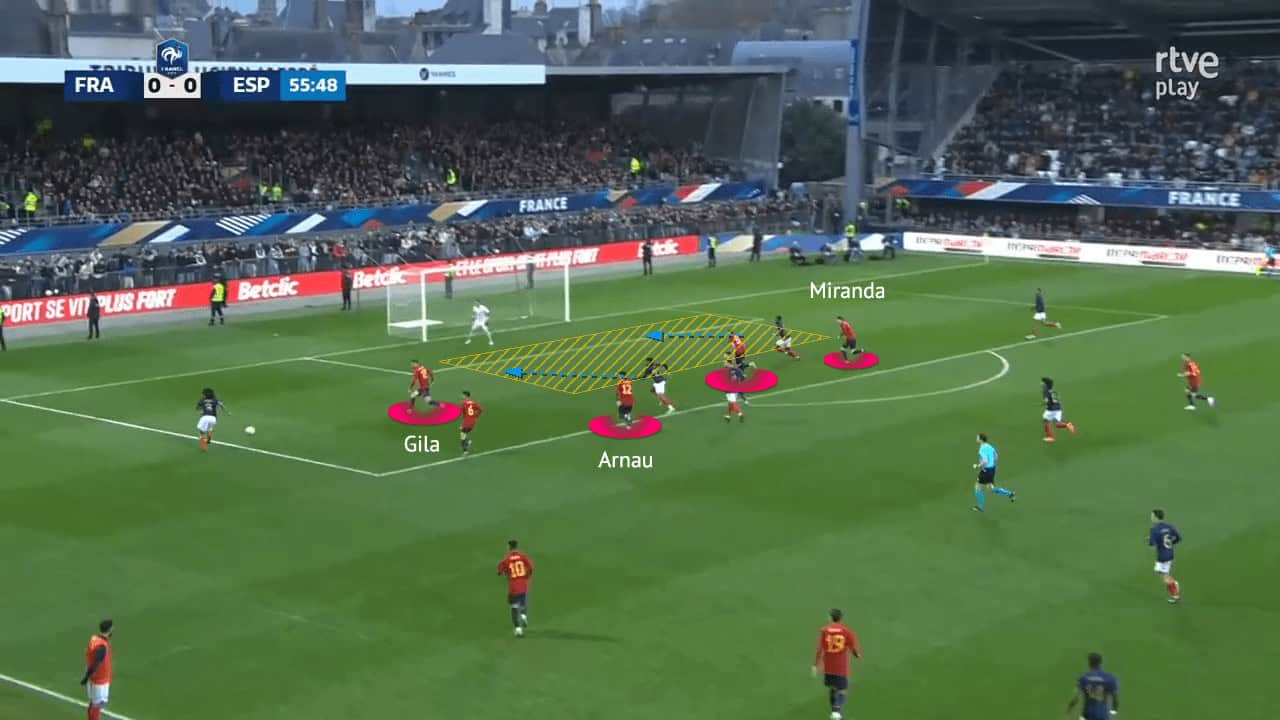
Spain’s defenders enjoy stepping up and engaging in individual duels a lot in their game, but that can become a problem as the last line can lose organisation. Meanwhile, the full-backs were not particularly strong in 1v1 duels, and the opponents could find space behind them too. If the holding midfielder was not in a good position to cover, they could concede chances.
This image shows Spain’s last line, and we can see that the players were quite out of position. The yellow zone highlighted was vacated by red shirts and it was attacked by France runners. Meanwhile, the right-back, Martínez, was completely out of his defensive position so Mario Gila had to cover, that was the reason why Spain could not defend the yellow zone with numbers.
It put them in a situation where they have to stop the cross rather than defend the delivery in the centre of the box because the central defenders did not share a good connection and the team did not have a leader to organize the defensive line in these situations.
Transitions
In transitions, Spain did not try to force the ball out to counterattack quickly because they were also happy at keeping possession. They also lacked players who could carry the ball over large distances, because the dribblers they had were not the types of players who could sprint across the field many times. Also, since Spain had the confidence of being better with the ball and attacking the opponent with their positional game, they do not need to bring the game into transitional plays and the players are not really matching this style in terms of their physical profile.
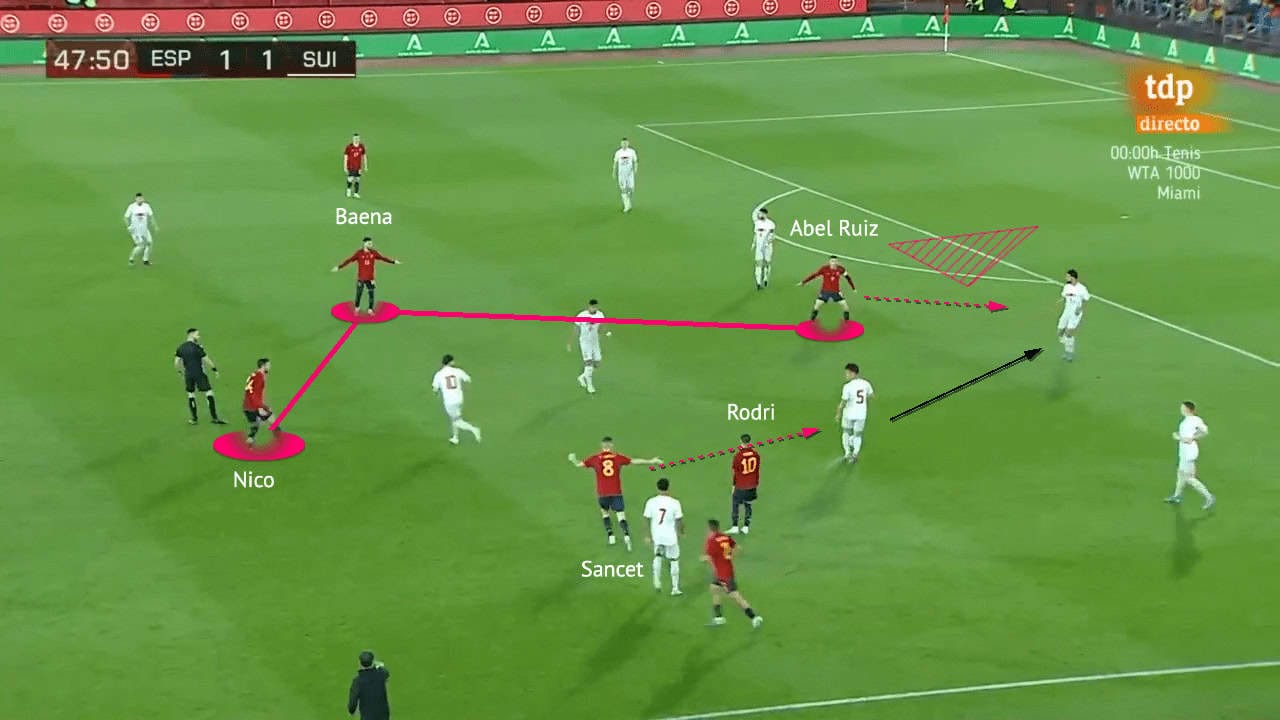
In defensive transitions, Spain shared similar ideas to their pressing game on managing the spacing. The above image shows the idea was to not expose the space centrally, so you could see Gonzaléz, Baena, and Ruiz using their body orientations to close the angle in the initial sequence. The initial objective of players around the ball is not to attack the ball — instead, they are more likely to press the receiver. As shown in this example, Ruiz will go to the central defender instead of running to the ball. But Spain has to be aware of not losing the ball in the first and second phases because the spacing of players will be too big to do any counter-pressing. In the friendly match against Switzerland, the first goal conceded is from the communication between Gonzaléz and Pacheco.
Attackers
It is clear that Ruiz will be the starting striker as Spain do not have many options when it comes to choosing a number ‘9’. The former Barcelona player has grown into SC Braga’s first team and scored 12 goals in all competitions so far. He also ranks 15th in terms of xG+xA in Liga NOS. On the flank, Denia has many options and some flexibility. Rodri should start, he likes to combine and he is decent on the ball, with 4.16 dribbles/90 and a success rate of 59.2%. Sergio Gómez can be an option but he has not been playing a lot for City in 2023. Denia will decide Depending on the game stage and the opponents.
Midfielders
As usual, Spain have midfielders with good technical ability at their disposal. Barcelona youth product González had 3.55 aerial duels/90 plus a success rate of 62.5% for the struggling Valencia side. He also contributed 9.61 recoveries/90 for the team. As we mentioned his role in the offensive phase, we can know the holding midfielder of the team will be crucial to the team’s attack and defence.
Sancet will also be important to the team, he has accumulated 100+ La Liga appearances for Athletic Club, scoring nine goals in the league this season. Both Baena and Sancet had similar numbers in progressive runs/90, 2.15 and 2.11, and these numbers are decent and higher than the likes of Gavi (1.79) and Gabri Veiga (1.81). They will help the progression of the team.
Defenders
Pacheco will be the key defender for Spain. Although he is yet to challenge Robin Le Normand and Aritz Elustondo’s starting positions at club level, he has decent defensive numbers, including a high defensive duels win % at 73.77% — fifth in La Liga. He’s also made 7.13 progressive runs/90, which is even better than Barcelona’s Andreas Christensen (6.91). Meanwhile, Miranda also had good numbers at PAdj interceptions (7.48), which is better than some left-backs such as Jordi Alba and Fran Garcia.
Key player
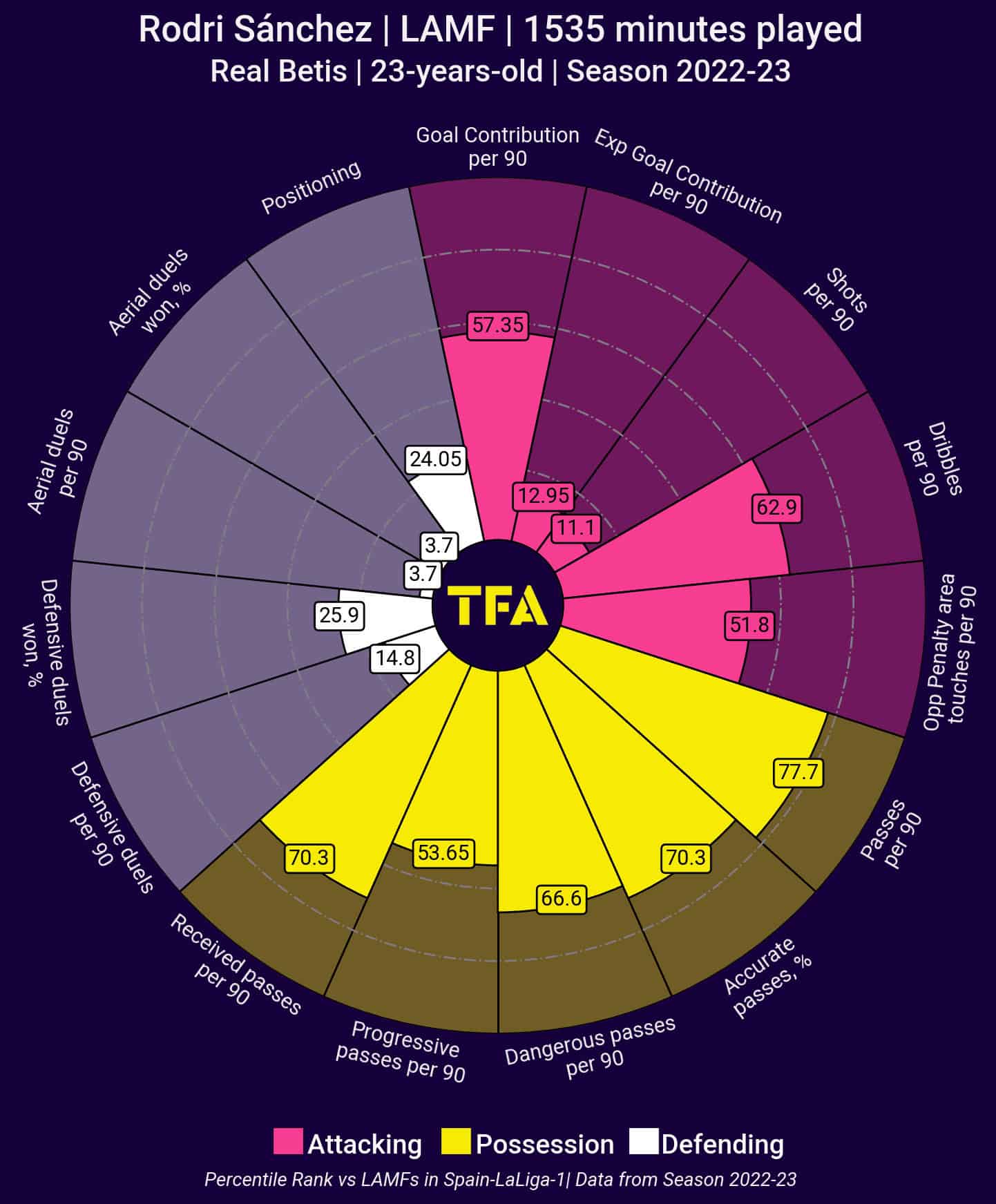
When it comes to selecting the best player, it is a hard call between Sancet and Rodri. Both players have good potential and they have established themselves in the top division of Spain already. But we are choosing Rodri in this scout report as he will be very important if Spain are going to create chances and score goals. He has good contributions in dribbles/90 with a percentile rank of 62.9 and goal contributions/90 at 57.35 in La Liga. Manuel Pellegrini also trusted him and Rodri has played 52% of total minutes so far, he will play a key role for Spain’s U21s in this tournament as well.
Tournament prediction
With a team full of La Liga talents and players moving abroad, we knew the potential of Spain U21 as explained in this analysis, so the expectation should be at least reaching the semi-final and with some luck, they could arrive at the final or even winning the championship. But despite all the qualities they have, this is still a team without leadership in key positions and with clear weaknesses in their game.

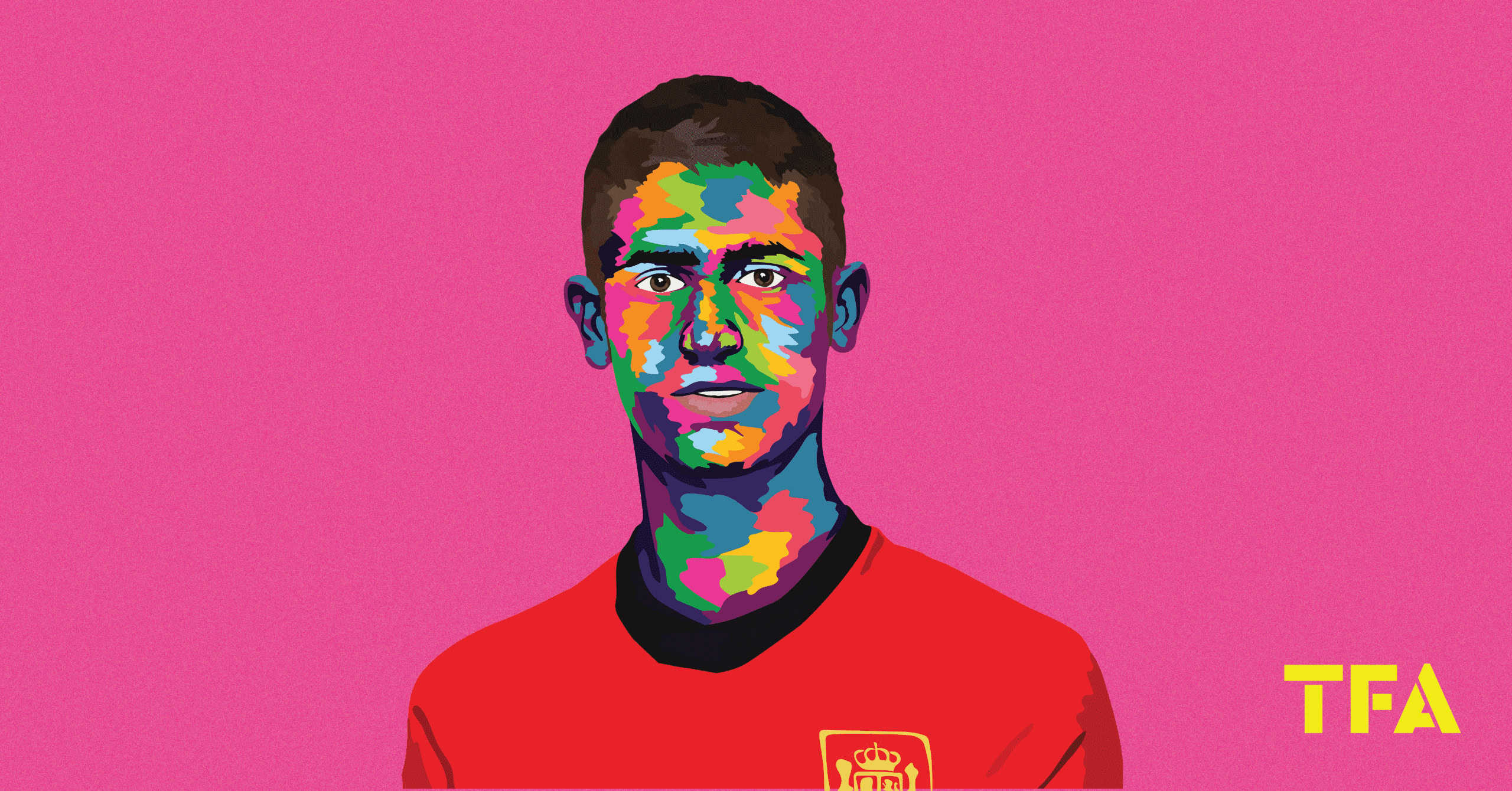


Comments